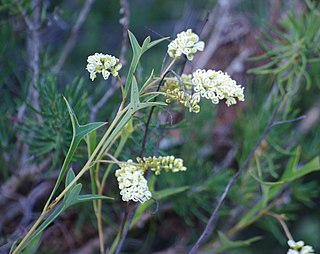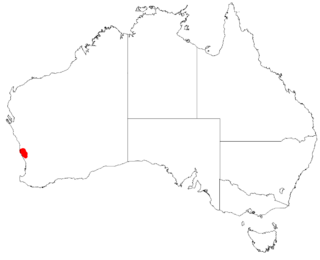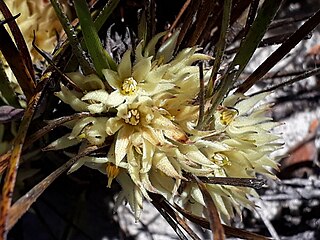
Banksia tricuspis, commonly known as Lesueur banksia or pine banksia, is a plant in the family Proteaceae and is endemic to a small area in the south-west of Western Australia. It is a stunted tree or shrub with narrow leaves and cylindrical spikes of golden-coloured flowers and it occurs in a geographic range of just 15 square kilometres near Jurien.

Grevillea vestita is a species of flowering plant in the family Proteaceae and is endemic to the southwest of Western Australia. It is an erect, spreading, prickly shrub with lobed leaves, the number and arrangement of lobes depending on subspecies, and more or less spherical to dome-shaped clusters of hairy, white to cream-coloured flowers sometimes tinged with pink.

Eremophila oldfieldii, commonly known as pixie bush, is a flowering plant in the figwort family, Scrophulariaceae and is endemic to Western Australia. It is a shrub or small tree with rough bark, broad, flat or narrow fleshy leaves and red, orange or yellow flowers.

Grevillea synapheae, commonly known as catkin grevillea, is species of flowering plant in the family Proteaceae and is endemic to the southwest of Western Australia. It is a prostrate to erect shrub usually with divided leaves with 3 to 7 triangular to more or less linear lobes, and clusters of white to creamy yellow flowers.

Conostylis aculeata, commonly known as prickly conostylis, is a flowering, tufted perennial plant in the family Haemodoraceae. It has flat leaves and yellow, hairy, tubular flowers. It is endemic to the south-west of Western Australia.

Grevillea bracteosa, also known as bracted grevillea, is a species of flowering plant in the family Proteaceae and is endemic to the south-west of Western Australia. It is an erect to spreading shrub usually with linear leaves, and oval to more or less spherical clusters of glabrous pale green to greenish-pink flowers with a pink or white style.

Grevillea obliquistigma is a species of flowering plant in the family Proteaceae and is endemic to the south-west of Western Australia. It is a spreading shrub with linear leaves, and conical to cylindrical clusters of creamy-white to yellowish cream-coloured flowers, sometimes tinged with pink.

Grevillea uniformis is species of flowering plant in the family Proteaceae and is endemic to the south-west of Western Australia. It is a shrub with broadly egg-shaped to fan-shaped leaves with sharply tipped teeth or lobes, and more or less spherical clusters of white flowers.

Quoya oldfieldii, commonly known as Oldfield's foxglove, is a flowering plant in the mint family Lamiaceae and is endemic to the south-west of Western Australia. It is an erect shrub with its branches and leaves densely covered with a layer of brownish hairs. The leaves are egg-shaped and the tube-shaped flowers are pink with purple spots inside.

Petrophile conifera is a species of flowering plant in the family Proteaceae and is endemic to southwestern Western Australia. It is a bushy, much-branched shrub with pinnate, sharply-pointed leaves, and oval heads of hairy, cream-coloured to yellowish white flowers.

Daviesia divaricata, commonly known as marno, is a species of flowering plant in the family Fabaceae and is endemic to the south-west of Western Australia. It is a low, spreading or erect and bushy shrub with phyllodes reduced to small, triangular scales, and orange and maroon flowers.

Conostylis albescens is a rhizomatous, tufted perennial plant species in the family Haemodoraceae, endemic to the south-west of Western Australia. Plants grow to between 12 and 17 cm high and produce yellow-cream-white flowers in August in the species' native range. The grey-green, hairy, leaves are 12–17 cm long and 0.8–1.5 mm wide.

Conostylis angustifolia is a rhizomatous, tufted perennial plant species in the family Haemodoraceae, endemic to the south-west of Western Australia. In September and October it produces yellow flowers in the species' native range.

Conostylis argentea is a rhizomatous, tufted perennial plant species in the family Haemodoraceae, endemic to the south-west of Western Australia. In July and August it produces white to cream flowers in the species' native range.

Conostylis bealiana is a flowering plant in the family Haemodoraceae and is endemic to Western Australia. It has green flat leaves and tubular dark yellow to orange-red flowers.
Stenanthemum limitatum is a species of flowering plant in the family Rhamnaceae and is endemic to the southwest of Western Australia. It is an erect or straggling shrub with sparsely hairy young stems, egg-shaped to fan-shaped leaves and greyish, softly-hairy heads of white or cream-coloured flowers.

Conostylis bracteata is a tufted perennial plant in the family Haemodoraceae and is endemic to the south-west of Western Australia. It is a rhizomatous, tufted, perennial, grass-like plant or herb with flat leaves and yellow, hairy, tubular flowers.

Conostylis breviscapa is a rhizomatous, tufted perennial, grass-like plant or herb in the family Haemodoraceae and is endemic to the south-west of Western Australia. It has flat leaves and yellow, hairy, tubular flowers.

Conostylis canteriata is a rhizomatous, tufted perennial, grass-like plant or herb in the family Haemodoraceae and is endemic to the south-west of Western Australia. It has stilted roots, flat leaves, and pale lemon-yellow tubular flowers.

Conostylis caricina is a flowering plant in the family Haemodoraceae and is endemic to the south-west of Western Australia. It is a rhizomatous, tufted perennial, grass-like plant or herb with flat leaves and heads of 6 to 8 creamy-yellow flowers.




















